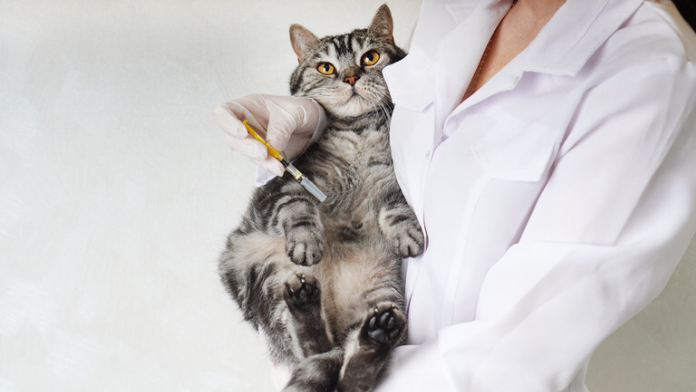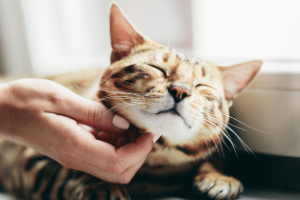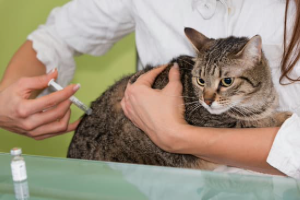
The Basics for Pet Owners
A new kitten is one of the most exciting yet unpredictable additions to a household. It can be an exciting time for families bringing a new kitten home, but it can also be overwhelming too! We wish we had an hour to sit down with every family that comes in to go over some truly important kitten topics, but unfortunately that reality is not often possible. Because of this, having resources for owners to read and keep on hand has become a must. We’ve included our top tips and considerations for vaccinations in this post for new kitten owners.
Determining what vaccinations are appropriate for your kitten should absolutely be a conversation with the vet.
This will be based on a list of core vaccines (vaccinations recommended for all kittens) then potential additional vaccinations based on your kitten’s lifestyle.

What is the difference between a high risk vs. low risk cat?
Risk level helps determine which vaccinations are appropriate or recommended for cats. WSAVA (World Small Animal Veterinary Association) designate some high risk cats as those with more potential exposure to infectious diseases. This includes cats that frequent catteries/boarding facilities, cats in multicat households, and cats that are indoor/outdoor (exposed to other cats and wildlife). Low risk cats are those who are indoor only and the sole pet in the house. This might also include households with multiple cats that are all indoor only.
Vaccines are typically started between 6-8 weeks of age and initial boosters may be continued until around 12-16 weeks of age.
Whether boosters are required and the duration of protection varies with each type of vaccine.
- Core vaccinations (recommended for all cats):
- Feline panleukopenia (parvovirus):
- While similar to parvo in dogs, feline panleukopenia is its own virus responsible for serious clinical disease in cats. Spread via bodily fluids, the virus can affect the intestinal tract and immune system. Signs can include respiratory problems, lethargy, diarrhea, and decreased appetite among others. It is highly contagious and may be fatal in severe cases.
- Feline herpes virus (FHV-1):
- FHV-1 is the agent also known as feline rhinotracheitis virus, a common cause of upper respiratory symptoms in cats. These may include conjunctivitis, corneal ulcers, sneezing, ocular discharge and nasal discharge. In severe cases, secondary bacterial infection may arise. Interestingly, the majority of cats have been exposed to FHV-1 and can remain positive throughout their lifetime. The virus is similar to herpes virus in other species, where once infected the virus remains and can become latent. This means it hides within the body and may sporadically cause clinical signs (respiratory), particularly during times of stress.
- Feline calicivirus:
- Calicivirus is an ugly virus also spread readily from cat to cat by bodily fluids. It is most commonly transmitted by respiratory secretions, particularly sneezing cats kept in small less ventilated areas. Because of this, kittens and cats in rescues, pet stores, catteries are at increased risk. Clinical signs often begin as respiratory in origin, but characteristic oral ulcerations may arise and cause severe pain. Signs may also develop in other body systems and the virus can be fatal.
- Note: Vaccinations for panleukopenia, herpes virus, and calicivirus are typically given together as a combination “upper respiratory” vaccination.
- This combination vaccination is often started around 8 weeks of age, then boostered 3-4 weeks later. High risk cats will then need a booster annually, whereas low risk cats may only require a booster every 3 years.
- Feline panleukopenia (parvovirus):

- Non-core vaccinations based on risk/lifestyle:
- Rabies virus:
- Rabies is not currently present in the UK (fortunately). That being said, pets travelling outside of the UK should absolutely be vaccinated for rabies as this virus has no cure, is harboured in many species, and is fatal to animals and humans. Rabies is required for international travel, and research should be done prior to animal transport for each country’s regulations.
- Can be given no earlier than 12 weeks. No initial boosters needed. Next rabies is due 1 year later, then is given every 3 years.
- Feline leukemia virus:
- FeLV is a virus that affects the immune system and is often fatal. The virus makes cats susceptible to a host of other diseases including blood disorders and cancer. It is often transmitted by biting/fighting with another cat that is FeLV positive, but can be spread by most bodily fluids as well as in utero from mother to baby. Typically cats are tested for the disease prior to vaccination to ensure they are negative.
- Requires two initial boosters given 3-4 weeks apart, then given annually to every 2 years. Can be started as early as 8 weeks of age.
- Rabies virus:
Key messages:
- Your vet can help you determine which vaccinations are appropriate for your kitten. Our goals are to pick the most appropriate course based on current veterinary standards as well as your pets exposure/risk level.
- Each vaccination works differently and may require different numbers of boosters.
For the most up to date vaccination guidelines, check out the following resources:
- British Small Animal Veterinary Association (BSAVA) Vaccination Position Statement
- World Small Animal Veterinary Association (WSAVA) Vaccination Guidelines
Dr. Kirsten Ronngren, DVM MRCVS
Ready to take the fuss out off pet healthcare? Get your VetBox subscription today and relax.